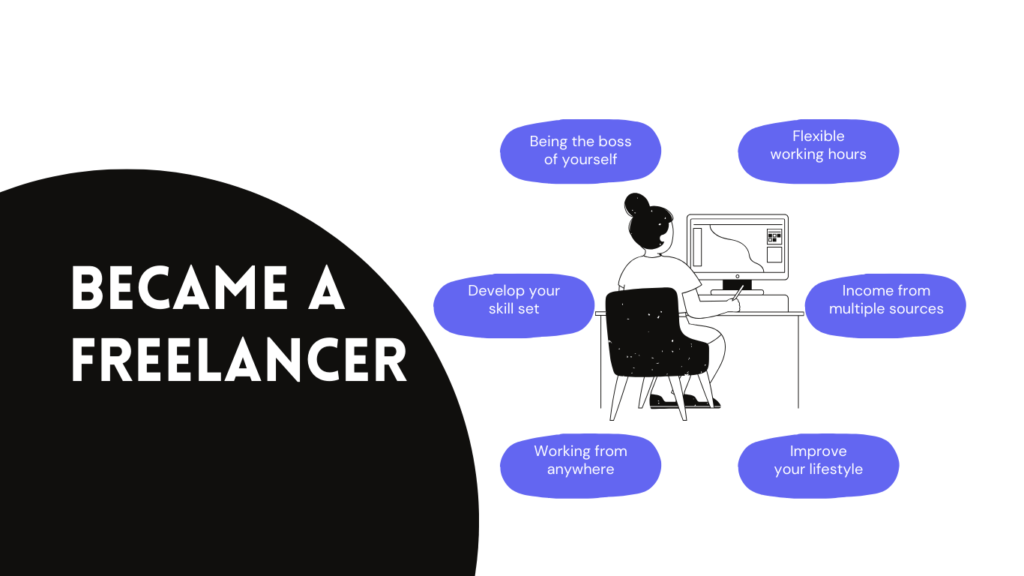Have you ever dreamed of working on your terms by pursuing your passion? Follow this guide, and you’ll learn how to start your freelance business and become your own boss.
Let’s get to it!
With the rise of remote work, freelancing became an increasingly popular job.
In fact, Fiverr found that 78% of companies will rely on freelancing in 2023 rather than hire additional staff.
Why should you tap into this market?
Running a freelancing business offers flexibility to work at your best during your most productive hours. With a strong commitment to maintaining a freelance business, you can start small and expand it gradually.
Moreover, most freelance work can be done no matter where you reside.
In addition, unlike traditional employment methods, freelancing can empower you to pursue your passion and work on projects that ignite your creativity and enthusiasm.
Now, let’s see what it’s going to take to start your freelancing business.
Your first step in building a freelance business is to find the right niche. When picking a niche, you should focus on a specific area of expertise. This will help you stand out.
Clients seeking a particular expert will be able to seek you out more easily. Imagine it as a beacon within the freelance landscape, clarifying to potential clients what you excel at and how you can meet their needs.
There are a few ways to identify a profitable niche.
1. Evaluate your skills, strengths, and areas of interest.
Consider what you’re passionate about and what you excel at. These qualities will drive your motivation and make your freelance journey more enjoyable.
2. Conduct market research to discover service demand within various niches.
Look for a relevant freelance industry experiencing growth. Understanding the market demand ensures that your chosen niche has a sizable pool of potential clients.
3. Consider your competition
Examine others offering similar services in your chosen niche. Analyze their strengths and weaknesses to pinpoint areas where you can excel and provide a unique value proposition.
4. Define your target audience
Determine the people or businesses most likely to benefit from your services. Tailor your approach to cater to their specific needs.
To get started,
There are a lot of freelancing business ideas that you can explore. Depending on your interests and skills, you can be a web designer, photographer, content writer, data analyst, and so much more.
Set Up Your Freelance Business
One of the initial steps in starting a freelance career is registering as a freelancer.
Registering as a Freelancer
You have several options for establishing your business entity, each with its legal implications and tax considerations. The most common business entity for self-employed freelancers is sole ownership. It means you and your business are considered one legal entity, providing a simple setup for your freelance business.
Alternatively, consider forming a Limited Liability Company, also known as LLC. This structure separates your personal assets from business liabilities. As a business owner, this offers greater security for your personal finances.
Obtain the necessary licenses and permits to build trust with your clients
To operate your freelance business legally, you may need specific licenses based on your location and the nature of your work. Research the licensing requirements in your area and ensure you obtain any necessary permits for small businesses. Seeking advice from local authorities or professional advisors can help you navigate this process more smoothly.
Maintaining a clear distinction between personal and business finances
Maintaining a clear distinction between personal and business finances is a great strategy for setting up a freelance business. You can open a separate bank account dedicated solely to your business transactions.
This will simplify accounting, making tracking income and expenses related to your freelance work easier.
Price your Freelance Services
Setting your price below the market average can be an effective way to attract clients. To set competitive prices, you must objectively examine what you’re bringing to the table and the quality of your services. Study the hiring costs of freelancers offering similar services and consider determinants such as:
- The value you bring
- Your work quality
- The customer support you’ll provide at the price you set.
By setting competitive prices that align with your unique skills and quality of service, you can attract more clients and position yourself as one of the best freelancers in the market. As for pricing models, there are several types you can apply for a freelance business.
Let’s review the most common ones.
- Project-based pricing
- Hourly pricing
- Retainer
Project-based pricing
First is project-based pricing. If you prefer a fixed-fee pricing model, charging for project-based services is ideal. This way, you can set a defined scope and deliver a clear timeline. Many clients prefer this pricing method since they know exactly how much they will pay.
In contrast, some freelancers may avoid a flat-rate pricing model since the project can take longer than expected, especially if clients repeatedly ask for revisions. To avoid this problem, create a cost breakdown and agree with customers about the number of revisions included.
Hourly Pricing
The second is hourly pricing. As the name suggests, you can charge your services by the hour, the simplest method of all pricing models. With it, you can just set an hourly rate for each service after calculating the expenses you’ll spend on tools and other factors in advance.
If you can manage this pricing model properly, you can have a straightforward process of tracking profitability, team hour management, and scheduling projects.
Retainer Model
And lastly, there’s the retainer model. This pricing model is ideal for targeting clients with recurring needs. It works by holding your business relationship with clients over time and will work closely on ongoing needs.
In other words, with this payment type, your business and the client will work together as partners rather than vendors. Generally, a retainer agreement lasts one year or at least six months. If you want to apply this pricing model, it is important to map out monthly goals and priorities. That way, you can have clear parameters of what aspects to achieve while calculating the budget to accomplish them.
Set a clear target of your expected costs for projects with fixed-fee pricing that would work in your business’s favor.
Build Your Freelance Brand
Building a freelance brand is essential if you wish to stand out in the competitive market. Your brand reflects who you are, what you offer, and how you provide value to clients. You can attract the right audience by following these steps.
Define Your Brand Identity
Establishing a brand identity is the first crucial step in building a freelance business. A strong brand identity separates your business from the competition and helps you resonate better with the target audience.
Start by understanding your values, mission, and unique strengths.
Determine what makes your services special and how it can benefit your target clients. Then, pick a memorable brand name relevant to your business so customers will instantly know what to expect from you.
Design a Professional Logo
Once you’ve found a proper brand name, the next step involves developing a compelling visual identity. Design an engaging and iconic logo to capture your audience’s attention and create a lasting impression.
If you’re not well-versed in creative design, use AI Logo Maker to get awesome logo ideas within minutes.
Simply enter your freelance business’s brand name, slogan, and industry, and the AI tool will generate several logo ideas for you.
All logos made with AI Logo Maker are fully customizable, and you can easily choose a color palette that represents your business more accurately.
More importantly, protect your intellectual property by registering trademarks for your brand name, logo, and product designs. Consult an intellectual property attorney to ensure proper protection if you can’t afford it.
Build an Impressive Website
A website serves as a digital storefront for your freelance business. It allows you to showcase your skills and attract new clients.
Today, dozens of platforms are available to ease the website-building process, with WordPress being the most popular option. Nowadays, many resources and plugins are available online to help you create a good-looking professional website.
With this AI tool, you’ll get a basic website ready by simply entering your brand’s name, choosing your website type, and describing your website in a few sentences.
Our AI-based algorithm will do the rest. If you need a follow-along tutorial on how to build a website, you’ll find a link here.
Create an Online Portfolio
Having a high-quality portfolio website is important. Not only does it enhance your online presence, but it also strengthens your credibility. No matter your line of work, you can have a digital portfolio to showcase your previous work and build a personal brand.
Here are a few tips to remember:
- Make sure to organize your portfolio website to be visually appealing and easy to navigate. It’ll make a stronger impression on potential clients.
- Then, to drive traffic to your portfolio, remember to implement some time-proven practices for an SEO-friendly website. For example, optimize your images and use relevant keywords for your content.
Engage With your Audience
Creating valuable content is key to attracting and retaining your audience. Write helpful and insightful blog posts, create videos, or host webinars to provide useful tips and demonstrate your expertise as a freelancer. While your content should be informative, entertaining, and engaging, it should also be aligned with your business’s goals and values.
If you need help writing content, use AI Assistant. AI Assistant is a WordPress plugin that automates content creation using AI. All you have to do is develop the initial idea for your post, and the AI will handle the rest.
It will analyze your input and automatically create a well-structured, SEO-friendly blog post with a title, introduction, paragraphs, headings, and conclusion.
Find Freelance Clients
Let’s discuss some effective approaches to getting more clients once you start freelancing.
Websites such as Fiverr and Upwork provide a platform for freelancers to connect with people looking for specific services.
Create a compelling profile highlighting your skills, experience, and projects. Also, link your portfolio website to your freelance profile to drive more traffic.
Then, you must actively search for relevant job postings and submit well-crafted proposals tailored to each client’s requirements.
More importantly, you need to be proactive in building your profile, gaining positive reviews, and establishing a strong reputation on the platform.
Pitch your Services
A well-crafted pitch can help you land new clients. A few quick tips can help you craft the perfect pitch for your services, so be sure to follow them carefully.
For example, understand the individual you’re pitching to and their needs. Then, tailor your pitch to match their interests. Be creative and show how your pitch can benefit your client. After all, this is your chance to show off your skills.
Manage Your Freelance Projects
Effective project management is essential for delivering high-quality work, meeting client expectations, and maintaining long-term client relationships.
I’ll give you some tips you can take note of to do this.
Set Clear Expectations
From the beginning of the project, clearly define the milestones and deadlines. Then, communicate any potential limitations or challenges affecting the project’s timeline or scope.
Maintain open communication
Regular and transparent communication is key to successful project management as a freelancer. Keep your clients informed about the progress of their projects, provide timely updates,
and promptly address any questions or concerns they may have.
Utilize project management tools
Consider using freelance project management tools to stay organized and streamline your workflow. Tools like Monday.com or Hive can help you manage tasks, track project progress, and collaborate efficiently with customers and team members.
Prioritize client satisfaction
Providing excellent customer service and prioritizing client satisfaction will help you build strong relationships and secure future projects.
And that’s all we have for you today. I hope these tips will help guide you through your freelancer journey. If you have great tips to share with other up-and-coming freelancers, leave your thoughts or questions in the comment section below.
Give this blog a like if you found it helpful for more valuable marketing tips and content about website development. Thank you for reading, and good luck on your online journey!





